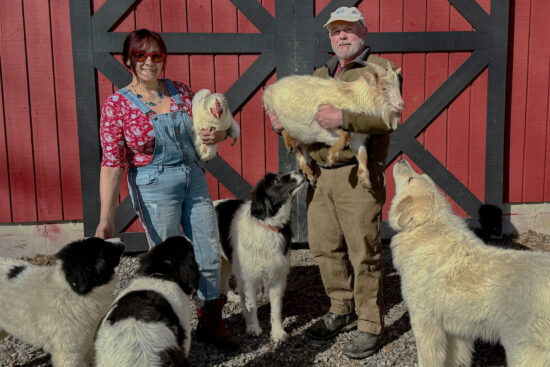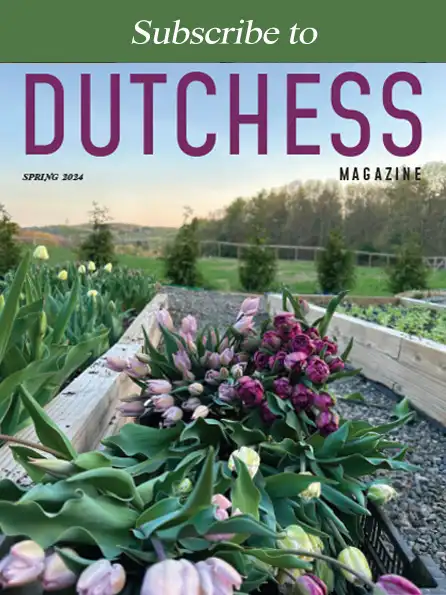May 6, 2025
Building Resiliency: Grants Help Farmers Grapple with Climate Change
Photograph by Wendy Carlson
By Wendy Carlson
At Hathor Hill Farm in Morris, a posse of Great Pyrenees dogs protect the cattle, goats, and chickens from predators—but they can’t safeguard the farm from the ravages of extreme weather.
“Last spring, there was so much water you could literally take a kayak down the road,” says Joe McCartin, as he walks along the foot-deep ruts of a washed-out access road that leads to his barns at the top of a pasture. Heavy rainfall severely flooded the dirt road, making it impassable, and damaging adjacent grazing land.
McCartin, a U.S. Air Force veteran, and his wife, Sally Amer, became first-time farmers five years ago when they purchased their 50-acre farm in the Lakeside section of Morris. There, they raise beef cattle, goats, and chickens, grow vegetables, and propagate mushrooms for products sold at their farmstand and at farmers markets.
Fortunately, this spring is looking a whole lot brighter for the fledgling farmers. The access road will be rerouted, trenches installed to divert water, and the pasture land restored with a $20,000 grant awarded to the couple recently by the Northwest Connecticut Land Conservancy (NCLC) through its Building Resiliency on Northwest Connecticut Farmland grant program. The initiative provides regional farmers with resources to enhance sustainability, increase agricultural productivity, and mitigate the effects of climate change. It was made possible by a grant from the Connecticut Department of Agriculture’s Climate-Smart Agriculture and Forestry program. Through the program, NCLC allocated more than $500,000, awarding a total of 48 grants to area farmers for “climate-smart” site assessments and implementation projects.
In Roxbury, Kirby Peters, who leases Maple Bank Farm — one of the oldest family-owned farms in the country — is using the farm’s $10,000 Building Resiliency grant award to purchase a raised bed mulch layer with a fertilizer hopper. The equipment will distribute fertilizer directly into the growing area while simultaneously creating raised beds that improve drainage.
“This helps during extreme weather events, when plants can end up sitting in water,” Peters says. “Proper fertilization ensures better plant vitality and crop outcomes. We’ve struggled with precision fertilizer application, and we know some fertilizer leaches out. The more efficient and precise we can be, the better.”

Peters echoes the concern voiced by many local farmers. “Climate mitigation is of the utmost importance for us,” he says. “With unpredictable weather patterns, we are increasingly forced to adapt.”
The program comes at a pivotal moment as cuts to federal funding for conservation and agriculture loom. So far, the NCLC has provided grants to meat, poultry, and vegetable farmers as well as a diverse range of producers, including a hops farm in Warren, a CBG farm in Harwinton, and Rowledge Pond Aquaculture, a hatchery in Sandy Hook.
Beyond combating extreme weather conditions, the initiative supports practices aimed at sequestering carbon and reducing emissions, which in turn improves water quality, enhances soil, and promotes biodiversity—all steps to help farmers thrive.—ctland.org






















